Developers
API References
Data Subject Request API
Data Subject Request API Version 1 and 2
Data Subject Request API Version 3
Platform API
Key Management
Platform API Overview
Accounts
Apps
Audiences
Calculated Attributes
Data Points
Feeds
Field Transformations
Services
Users
Workspaces
Warehouse Sync API
Warehouse Sync API Overview
Warehouse Sync API Tutorial
Warehouse Sync API Reference
Data Mapping
Warehouse Sync SQL Reference
Warehouse Sync Troubleshooting Guide
ComposeID
Warehouse Sync API v2 Migration
Bulk Profile Deletion API Reference
Calculated Attributes Seeding API
Custom Access Roles API
Data Planning API
Group Identity API Reference
Pixel Service
Profile API
Events API
mParticle JSON Schema Reference
IDSync
Client SDKs
AMP
AMP SDK
Android
Initialization
Configuration
Network Security Configuration
Event Tracking
User Attributes
IDSync
Screen Events
Commerce Events
Location Tracking
Media
Kits
Application State and Session Management
Data Privacy Controls
Error Tracking
Opt Out
Push Notifications
WebView Integration
Logger
Preventing Blocked HTTP Traffic with CNAME
Linting Data Plans
Troubleshooting the Android SDK
API Reference
Upgrade to Version 5
Cordova
Cordova Plugin
Identity
Direct Url Routing
Direct URL Routing FAQ
Web
Android
iOS
iOS
Workspace Switching
Initialization
Configuration
Event Tracking
User Attributes
IDSync
Screen Tracking
Commerce Events
Location Tracking
Media
Kits
Application State and Session Management
Data Privacy Controls
Error Tracking
Opt Out
Push Notifications
Webview Integration
Upload Frequency
App Extensions
Preventing Blocked HTTP Traffic with CNAME
Linting Data Plans
Troubleshooting iOS SDK
Social Networks
iOS 14 Guide
iOS 15 FAQ
iOS 16 FAQ
iOS 17 FAQ
iOS 18 FAQ
API Reference
Upgrade to Version 7
React Native
Getting Started
Identity
Unity
Upload Frequency
Getting Started
Opt Out
Initialize the SDK
Event Tracking
Commerce Tracking
Error Tracking
Screen Tracking
Identity
Location Tracking
Session Management
Web
Initialization
Configuration
Content Security Policy
Event Tracking
User Attributes
IDSync
Page View Tracking
Commerce Events
Location Tracking
Media
Kits
Application State and Session Management
Data Privacy Controls
Error Tracking
Opt Out
Custom Logger
Persistence
Native Web Views
Self-Hosting
Multiple Instances
Web SDK via Google Tag Manager
Preventing Blocked HTTP Traffic with CNAME
Facebook Instant Articles
Troubleshooting the Web SDK
Browser Compatibility
Linting Data Plans
API Reference
Upgrade to Version 2 of the SDK
Xamarin
Getting Started
Identity
Alexa
Server SDKs
Node SDK
Go SDK
Python SDK
Ruby SDK
Java SDK
Quickstart
Android
Overview
Step 1. Create an input
Step 2. Verify your input
Step 3. Set up your output
Step 4. Create a connection
Step 5. Verify your connection
Step 6. Track events
Step 7. Track user data
Step 8. Create a data plan
Step 9. Test your local app
iOS Quick Start
Overview
Step 1. Create an input
Step 2. Verify your input
Step 3. Set up your output
Step 4. Create a connection
Step 5. Verify your connection
Step 6. Track events
Step 7. Track user data
Step 8. Create a data plan
Python Quick Start
Step 1. Create an input
Step 2. Create an output
Step 3. Verify output
Guides
Partners
Introduction
Outbound Integrations
Outbound Integrations
Firehose Java SDK
Inbound Integrations
Compose ID
Data Hosting Locations
Glossary
Rules Developer Guide
API Credential Management
The Developer's Guided Journey to mParticle
Guides
Customer 360
Overview
User Profiles
Overview
User Profiles
Group Identity
Overview
Create and Manage Group Definitions
Calculated Attributes
Calculated Attributes Overview
Using Calculated Attributes
Create with AI Assistance
Calculated Attributes Reference
Predictive Attributes
What are predictive attributes?
Getting Started
Create an Input
Start capturing data
Connect an Event Output
Create an Audience
Connect an Audience Output
Transform and Enhance Your Data
Segmentation
New Audiences Experience
Audiences Overview
Create an Audience
Connect an Audience
Manage Audiences
FAQ
Classic Audiences Experience
Real-time Audiences (Legacy)
Standard Audiences (Legacy)
New vs. Classic Experience Comparison
Predictive Audiences
Predictive Audiences Overview
Using Predictive Audiences
Platform Guide
Billing
Usage and Billing Report
The New mParticle Experience
The new mParticle Experience
The Overview Map
Observability
Observability Overview
Observability User Guide
Observability Troubleshooting Examples
Observability Span Glossary
Platform Settings
Key Management
Event Forwarding
Notification Center (Early Access)
System Alerts
Trends
Introduction
Data Retention
Data Catalog
Connections
Activity
Data Plans
Live Stream
Filters
Rules
Blocked Data Backfill Guide
Tiered Events
mParticle Users and Roles
Analytics Free Trial
Troubleshooting mParticle
Usage metering for value-based pricing (VBP)
IDSync
IDSync Overview
Use Cases for IDSync
Components of IDSync
Store and Organize User Data
Identify Users
Default IDSync Configuration
Profile Conversion Strategy
Profile Link Strategy
Profile Isolation Strategy
Best Match Strategy
Aliasing
Analytics
Introduction
Core Analytics (Beta)
Setup
Sync and Activate Analytics User Segments in mParticle
User Segment Activation
Welcome Page Announcements
Settings
Project Settings
Roles and Teammates
Organization Settings
Global Project Filters
Portfolio Analytics
Analytics Data Manager
Analytics Data Manager Overview
Events
Event Properties
User Properties
Revenue Mapping
Export Data
UTM Guide
Analyses
Analyses Introduction
Segmentation: Basics
Getting Started
Visualization Options
For Clauses
Date Range and Time Settings
Calculator
Numerical Settings
Segmentation: Advanced
Assisted Analysis
Properties Explorer
Frequency in Segmentation
Trends in Segmentation
Did [not] Perform Clauses
Cumulative vs. Non-Cumulative Analysis in Segmentation
Total Count of vs. Users Who Performed
Save Your Segmentation Analysis
Export Results in Segmentation
Explore Users from Segmentation
Funnels: Basics
Getting Started with Funnels
Group By Settings
Conversion Window
Tracking Properties
Date Range and Time Settings
Visualization Options
Interpreting a Funnel Analysis
Funnels: Advanced
Group By
Filters
Conversion over Time
Conversion Order
Trends
Funnel Direction
Multi-path Funnels
Analyze as Cohort from Funnel
Save a Funnel Analysis
Explore Users from a Funnel
Export Results from a Funnel
Saved Analyses
Manage Analyses in Dashboards
Query Builder
Data Dictionary
Query Builder Overview
Modify Filters With And/Or Clauses
Query-time Sampling
Query Notes
Filter Where Clauses
Event vs. User Properties
Group By Clauses
Annotations
Cross-tool Compatibility
Apply All for Filter Where Clauses
Date Range and Time Settings Overview
User Attributes at Event Time
Understanding the Screen View Event
User Aliasing
Dashboards
Dashboards––Getting Started
Manage Dashboards
Dashboard Filters
Organize Dashboards
Scheduled Reports
Favorites
Time and Interval Settings in Dashboards
Query Notes in Dashboards
Analytics Resources
The Demo Environment
Keyboard Shortcuts
User Segments
Warehouse Sync
Data Privacy Controls
Data Subject Requests
Default Service Limits
Feeds
Cross-Account Audience Sharing
Approved Sub-Processors
Import Data with CSV Files
Import Data with CSV Files
CSV File Reference
Glossary
Video Index
Analytics (Deprecated)
Identity Providers
Single Sign-On (SSO)
Setup Examples
Introduction
Developer Docs
Introduction
Integrations
Introduction
Rudderstack
Google Tag Manager
Segment
Data Warehouses and Data Lakes
Advanced Data Warehouse Settings
AWS Kinesis (Snowplow)
AWS Redshift (Define Your Own Schema)
AWS S3 Integration (Define Your Own Schema)
AWS S3 (Snowplow Schema)
BigQuery (Snowplow Schema)
BigQuery Firebase Schema
BigQuery (Define Your Own Schema)
GCP BigQuery Export
Snowflake (Snowplow Schema)
Snowplow Schema Overview
Snowflake (Define Your Own Schema)
Developer Basics
Aliasing
Integrations
24i
Event
Aarki
Audience
Abakus
Event
Actable
Feed
ABTasty
Audience
AdChemix
Event
AdMedia
Audience
Adobe Audience Manager
Audience
Adobe Marketing Cloud
Cookie Sync
Server-to-Server Events
Platform SDK Events
Adobe Target
Audience
Adobe Campaign Manager
Audience
AdPredictive
Feed
AgilOne
Event
Algolia
Event
Amazon Advertising
Audience
Alooma
Event
Amazon Kinesis
Event
Amazon Redshift
Data Warehouse
Amazon S3
Event
Amazon SNS
Event
Amobee
Audience
Amazon SQS
Event
Anodot
Event
Antavo
Feed
Apptentive
Event
Apptimize
Event
Apteligent
Event
Attractor
Event
Microsoft Azure Blob Storage
Event
Awin
Event
Bidease
Audience
Bing Ads
Event
Bluecore
Event
Bluedot
Feed
Branch S2S Event
Event
Bugsnag
Event
Cadent
Audience
Census
Feed
Conversant
Event
comScore
Event
Crossing Minds
Event
Custom Feed
Custom Feed
Datadog
Event
Databricks
Data Warehouse
Didomi
Event
Dynalyst
Audience
Edge226
Audience
Emarsys
Audience
Epsilon
Event
Everflow
Audience
Facebook Offline Conversions
Event
Google Analytics for Firebase
Event
Flurry
Event
Flybits
Event
ForeSee
Event
FreeWheel Data Suite
Audience
Friendbuy
Event
Google Ad Manager
Audience
Google Analytics
Event
Google Analytics 4
Event
Google BigQuery
Audience
Data Warehouse
Google Enhanced Conversions
Event
Google Marketing Platform
Cookie Sync
Audience
Event
Google Marketing Platform Offline Conversions
Event
Google Pub/Sub
Event
Google Tag Manager
Event
Heap
Event
Herow
Feed
Hightouch
Feed
Hyperlocology
Event
Impact
Event
Ibotta
Event
InMarket
Audience
ID5
Kit
Intercom
Event
Inspectlet
Event
ironSource
Audience
Kafka
Event
Kissmetrics
Event
Kubit
Event
LaunchDarkly
Feed
LifeStreet
Audience
LiveLike
Event
Liveramp
Audience
Localytics
Event
MadHive
Audience
mAdme Technologies
Event
Marigold
Audience
Mediasmart
Audience
MediaMath
Audience
Microsoft Azure Event Hubs
Event
Mintegral
Audience
Monetate
Event
Movable Ink - V2
Event
Movable Ink
Event
Multiplied
Event
Nami ML
Feed
Nanigans
Event
NCR Aloha
Event
Neura
Event
OneTrust
Event
Oracle BlueKai
Event
Paytronix
Feed
Persona.ly
Audience
Personify XP
Event
Plarin
Event
Quadratic Labs
Event
Qualtrics
Event
Quantcast
Event
Rakuten
Event
Regal
Event
Reveal Mobile
Event
RevenueCat
Feed
Salesforce Mobile Push
Event
Salesforce Sales and Service Cloud
Event
Scalarr
Event
Shopify
Feed
Custom Pixel
Signal
Event
SimpleReach
Event
Singular-DEPRECATED
Event
Skyhook
Event
Slack
Event
Smadex
Audience
SmarterHQ
Event
Snowflake
Data Warehouse
Snapchat Conversions
Event
Snowplow
Event
Splunk MINT
Event
StartApp
Audience
Talon.One
Audience
Event
Feed
Loyalty Feed
Tapad
Audience
Tapjoy
Audience
Taptica
Audience
Taplytics
Event
Teak
Audience
The Trade Desk
Cookie Sync
Audience
Event
Ticketure
Feed
TUNE
Event
Triton Digital
Audience
Valid
Event
Vkontakte
Audience
Vungle
Audience
Webhook
Event
Webtrends
Event
White Label Loyalty
Event
Wootric
Event
Xandr
Audience
Cookie Sync
Yahoo (formerly Verizon Media)
Cookie Sync
Audience
Yotpo
Feed
YouAppi
Audience
Primer
Event
Connections
mParticle provides multiple data flows to ensure different kinds of data travel from a client application or the web (input) to a destination (output).
Data Forwarding and Connections
Data about an event, including individual attributes, may be forwarded from the input to an output in a variety of ways:

- Server-side: Data is forwarded from the web or client app to mParticle servers, stored there, and from there is forwarded on to an output or destination such as Braze. For these types of forwarding, no client setup is needed, because the client communicates directly with mParticle.
- Client-side: Data is forwarded from the web or client app directly to the output, unseen by mParticle servers. For this type of forwarding, you must set up your client, usually by adding a kit to the platform SDK of the client app.
Some integrations allow you to choose either server-side or client-side when you configure a connection.
Connection Workflow
No matter which data flow your integration uses, a connection is required. A connection is the combination of an input, an output, and the configuration information required to make the connection work. Most of the configuration information is specified in the mParticle UI, but some values may need to be fetched from the output, and you may need to add a kit to an SDK for some client-side integrations.
The Connections screen controls how event data from your inputs (iOS, Android, Web, Feeds, etc) is forwarded to your output platforms. You must set up a separate connection for each input-output-configuration combination. For each connection, you have several opportunities to cleanse and filter your data, to ensure that each output receives the data you want it to receive, in the correct format.
Each output has its own requirements, so the process for setting up each connection is a little different. However, all connections require these basic steps:
- Create a connection.
- If needed, add a kit to the SDK for your input platform.
- Activate the connection.
- Verify that data is being forwarded.
Create a Connection
Data flows once an input and output are connected and the connection is active.
1. Select an input
- Navigate to Data Platform > Setup > Connections in the mParticle UI.
- From the list of available configured inputs, select the input you want to connect to an output. If the list is empty, go to Data Platform > Setup > Inputs to create an input.
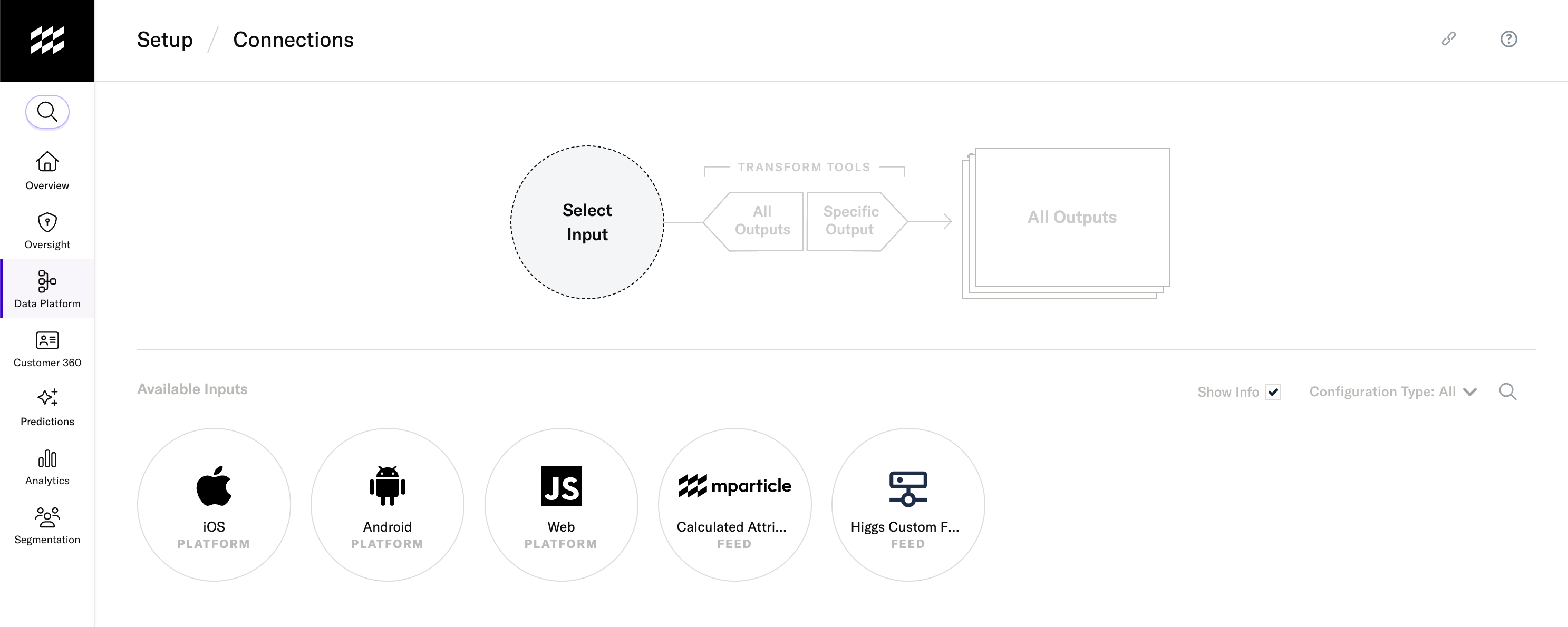
2. Apply ‘All Outputs’ transformations
Once you have an input selected, you can set up transformations that are applied to all outputs connected to that input. Click All Outputs to see options.
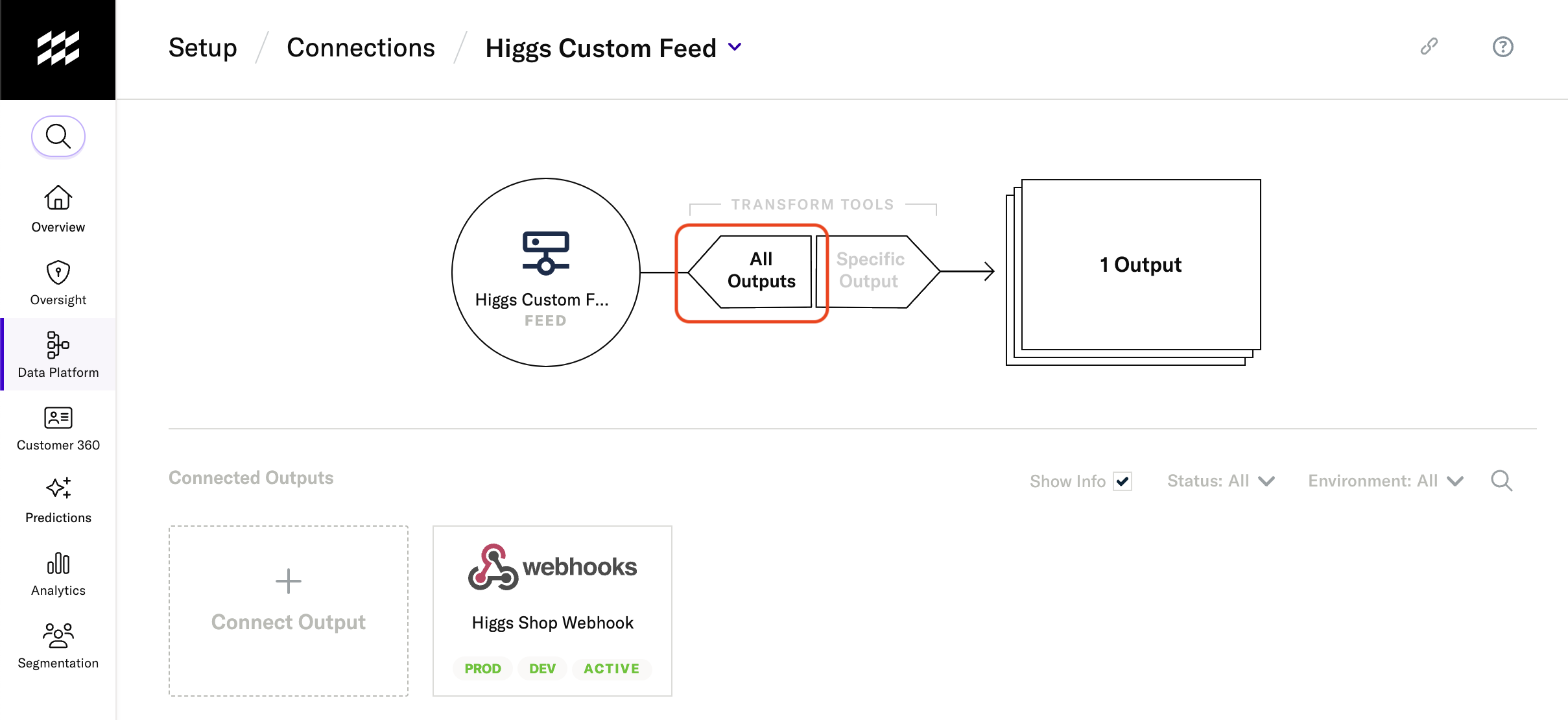
There are two transformations that can be applied here:
- Rules
- User Splits
3. Select an output
Once you have selected an input, you will see a list of available outputs that can receive data from your selected input. If this list is empty, go to Data Platform > Setup > Outputs to configure an output.
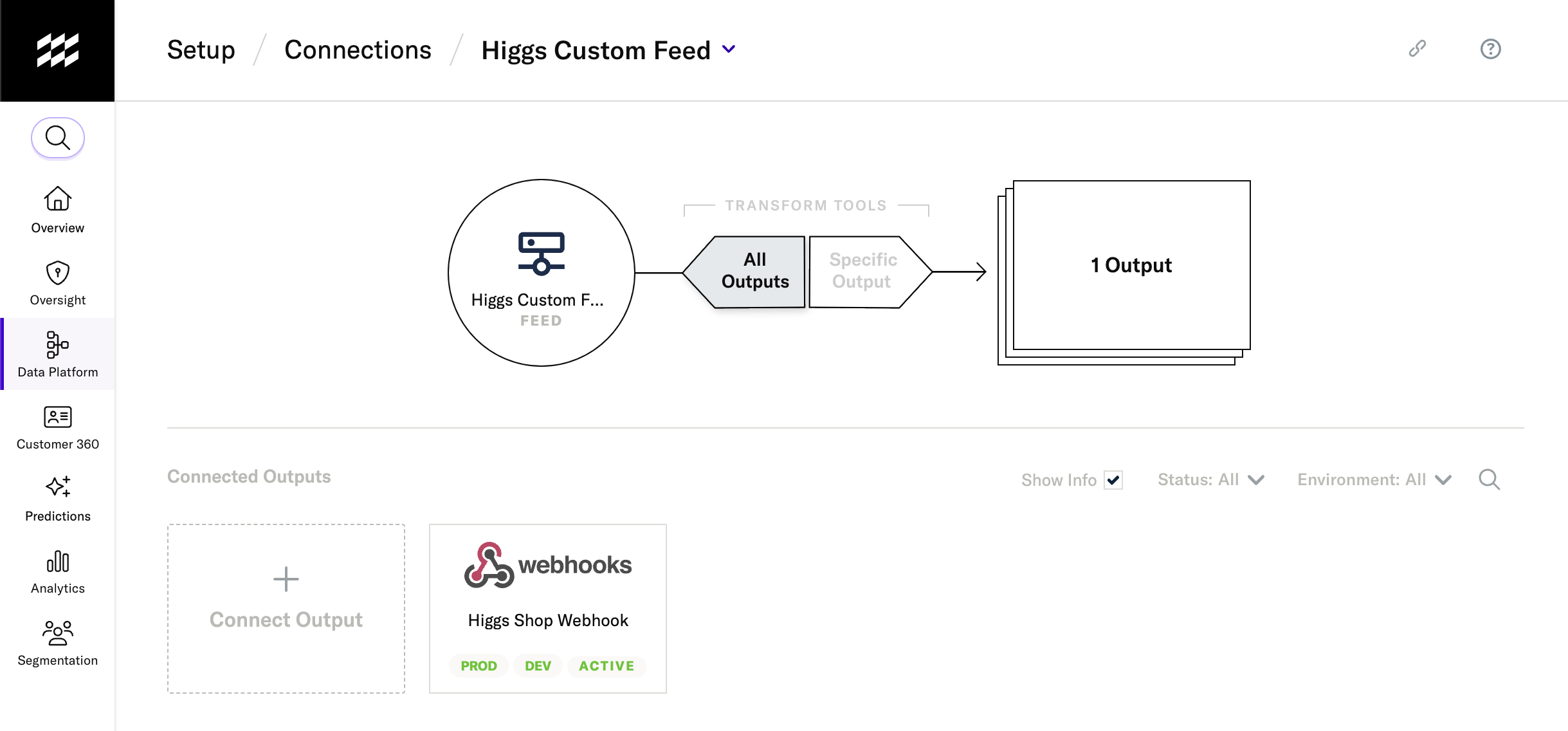
The mParticle UI may indicate that you need or may need to add a reference to a kit in your platform dependency configuration. You can do this after you create the connection but before you change the Connection Status to active. See Add a Kit for more information.
4. Complete Connection Settings
Complete any settings that apply to the connection. These will be different for every output but can include:
- Credentials or Account/Workspace identifiers
- What user identifiers and attributes should be sent. You must choose a User Identification (identity type) or data may not flow.
- Encoding to be used for identifying data
- How custom attributes should be mapped
- How to handle attributes specific to the Output
-
The minimum platform version of your input that the connection will forward data from.
-
If you set the Min Platform Version connection setting, then mParticle will only forward data from inputs with an
application_versionthat is equal to or greater than the version you set. This allows you to create a separate connection for different versions of your app.
-
5. Apply ‘Specific Output’ transformations
The second set of transformations apply only to your selected Output. Click Specific Output to see options. Specific output transformations include:
- Event Filter - note, this is not part of Connections Screen but should be configured before the next step if needed.
- Specific Outputs Rules
- Forwarding Rules
- Custom Mappings
- User Sampling
6. Add a kit
When you configured your output in step 3, the mParticle UI may have indicated that you do need or may need a kit added to the SDK for your app or web pages:
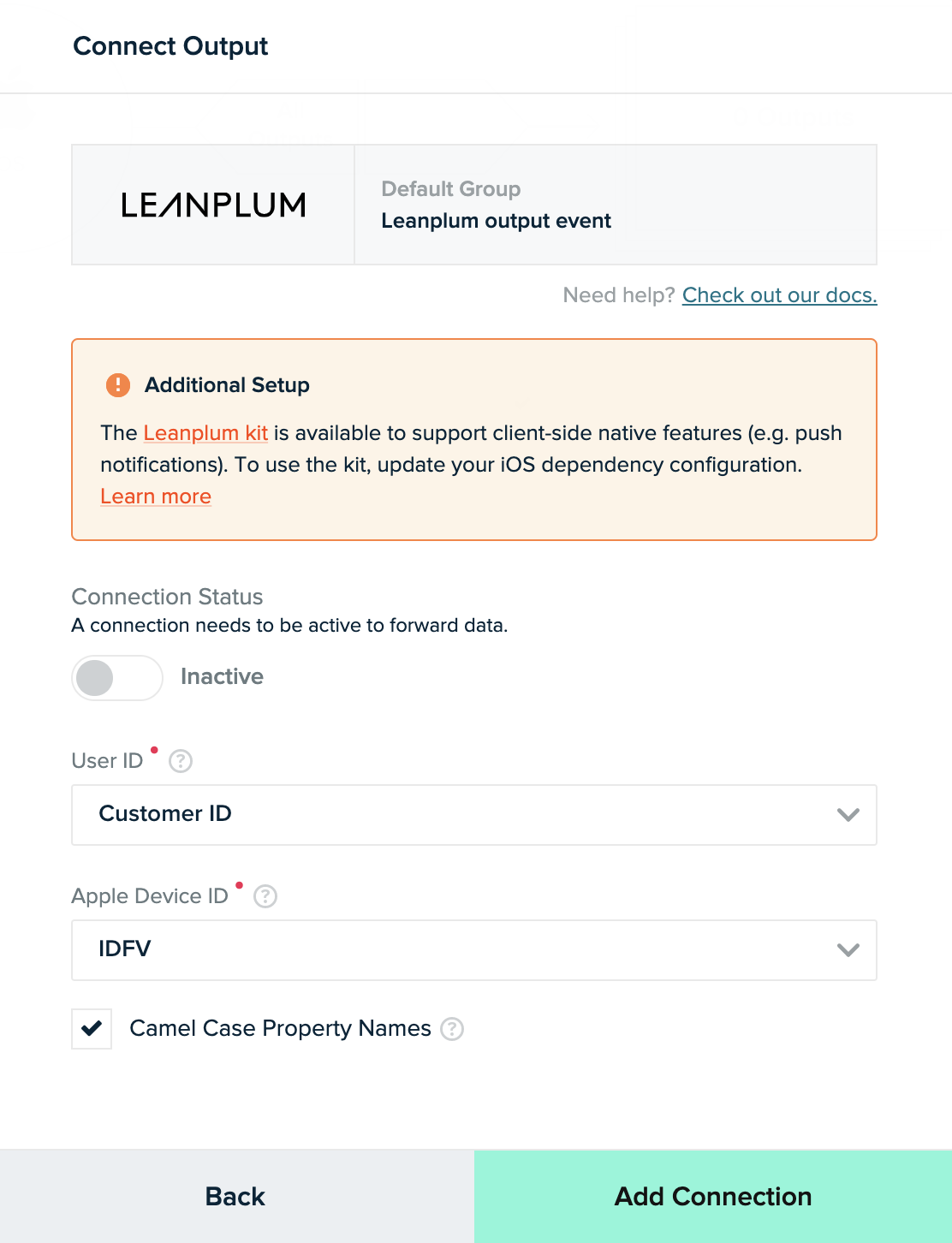
If so, check the integration documentation for your output. If a kit is required, follow the instructions for adding the kit to your input platform dependency configuration.
7. Activate the connection
After you have completed the required settings, set up any transformations, and added a kit (if needed), you are ready to activate the connection:
- Navigate to Data Platform > Setup > Connections.
- Select the input for your connection.
- Click the output you are ready to activate.
- Click the Connection Settings gear icon.
- Click the Connection Status slider so it displays Active.
- Click Save.
Very large data volumes may take up to 48 hours to process. To reduce processing time, reduce the number of sessions your account sends to fewer than 200,000 per day.
Verify Your connection
To verify your connection is working, first look at Live Stream to make sure mParticle is successfully ingesting data from your input and forwarding it to your output. Finally, log into your output integration and look for the data that was sent from mParticle.
1. Verify that data is flowing from your input to your output through mParticle
- Wait for the time indicated in the mParticle UI to ensure your connection has been activated. Additionally, some outputs such as Google Analytics have their own processing delays. Check the “Data Processing” section of [the integration documentation(/integrations) for your output.
-
Open Data Platform > Live Stream and select the following values:
- The input from Inputs
- The output from Outputs
- In Message Direction, select Both In and Out to check whether events are being forwarded.
- In Device, leave the default value All Dev Data unless you are verifying the flow to a device in production. In that case, choose the relevant device.
- Check that you have chosen a User Identification (identity type).
- Events should be listed in the order they are ingested:
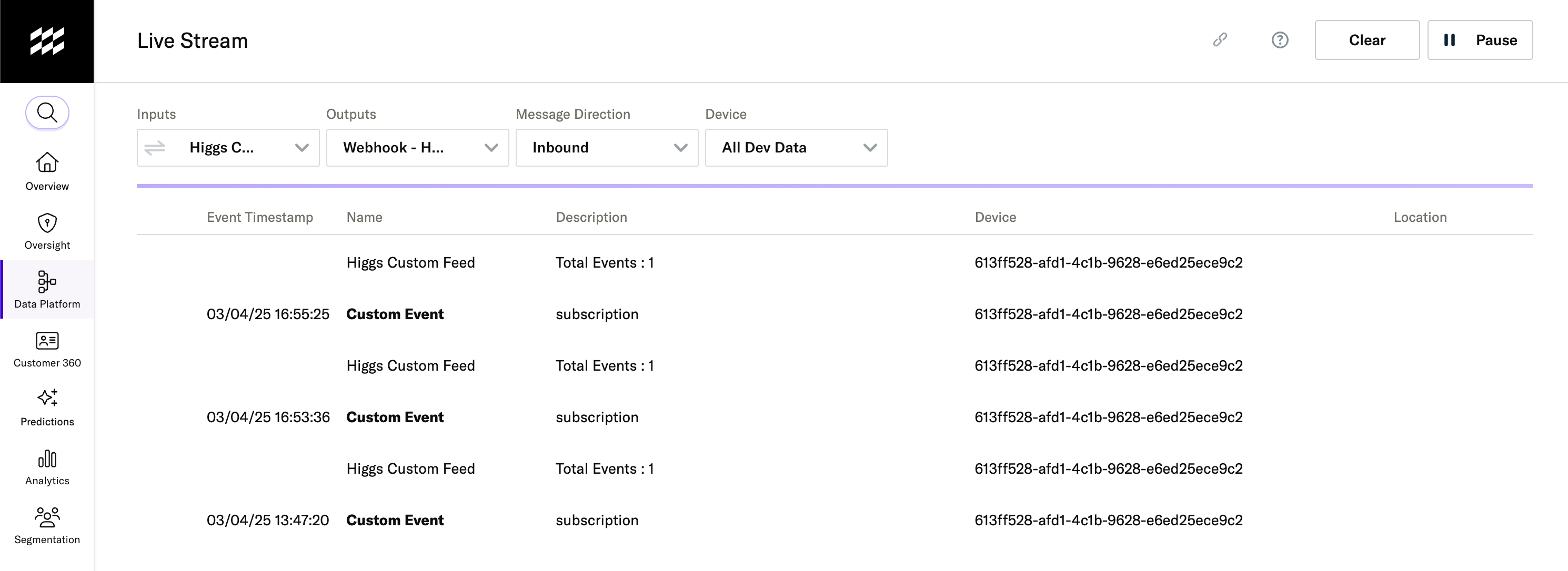
If you don’t see events being forwarded, troubleshoot your connection.
2. Verify that data is arriving in your output
To verify that data is arriving in your output:
- In mParticle, go to Data Platform > Live Stream and make note of a specific event. The
event_idis a helpful event attribute to note as this is unique for each event ingested. - Log into the provider for your output integration.
- Search for the specific event that you noted in mParticle.
If you don’t see events being forwarded, refer to the following troubleshooting guide.
3. Troubleshooting your connection
Follow these steps to troubleshoot a connection:
- Make sure you have waited for the time period specified in the mParticle UI before troubleshooting further.
- Check Oversight > System Alerts for any fatal errors or warnings and resolve them.
- If your events are not appearing in the output although the mParticle Live Stream suggests that the connection is active, follow the steps in Verify your connection to ensure your connection is working. Although Live Stream has indicated that events are forwarded downstream, there might be issues downstream that prevent successful forwarding. The next steps will help you find this type of problem.
- If you have tracing enabled for your input, check for any insights or warnings using Observability.
- Does your connection depend on a kit? Does your connection use a kit to forward data downstream? Has the kit been included in your application? If yes, check your application for HTTP requests directed to the partner. Have they succeeded or are they reporting errors?
- Does your connection use batch forwarding? Some outputs use batch forwarding. You might have to wait longer for events to arrive in these systems (approximately 10 minutes or after several event batches have been collected).
Still not sure what’s wrong? Contact mParticle Support.
All Outputs Transformations
See Rules for more information on all-output rules.
Specific Output Transformations
mParticle lets you customize the data that you send to each output. There are many reasons to do this, including:
- Filtering out personally identifiable information (PII);
- Filtering out data containing company insights you don’t want to share with a particular service;
- Filtering out events that you don’t need to track in a particular service;
- Filtering out information from places or customer types you don’t want to track in a particular service;
- Enriching the data you send to a service with extra user info from an external source;
- Reformatting your data to match what a particular service accepts.
The Data Filter
Unlike other transformations, the data filter exists on its own page, separate from the Connections screen. A data filter allows you to decide which events/attributes you want to send to each output. By default, all event attributes are enabled when you first activate a connection. From the event filter you can:
- Decide whether new events and attributes should be forwarded by default.
- Turn forwarding on/off for each event, by event name.
- Turn forwarding on/off for attributes of each event, by attribute name.
See The Data Filter for more information.
Forwarding Rules
Like the event filter, forwarding rules let you filter out events from being sent to an Output. But where the event filter is based on event and attribute names, forwarding rules look at values, which lets you build some more complex conditions. There are several types of forwarding rules.
- Attribute: Attribute rules take an event attribute name and a value. You can choose to either not forward events that match the rule, or to only forward events that match the rule, excluding all others. Greater than / less than comparisons are not possible. Matching is case-sensitive and exact. If an attribute is criteria for the forwarding rule, but is omitted from the source payload, it is treated as if the attribute key exists and the value doesn’t match.
- Attribution: Attribution rules filter events according to Publisher information. You can choose to exclude events attributed to a specific publisher, or forward only events attributed to that publisher.
- Consent: Data privacy controls allow you to filter events based on whether a user has given consent to a particular data collection purpose.
- ID Sync: IDSync rules allow you to only forward data from logged-in users. A user that’s logged in has at least one Login ID, as defined by your Identity Strategy.
User Sampling
User Sampling is applied to a single output and sends only a subset, or sample of your data to an output. The main reason to do this is to control costs on services that charge by volume of data. Data is sampled on a user level, not an event level - if you select a 50% sample, mParticle forwards all data received from half of your users, not half of each user’s data.

Specific Output Rules
See Rules for more information about specific-output rules.
Custom Mappings
Some services allow your incoming events to be translated into events specific to the service. For example, if you have a custom event named “NextLevel”, typically this event would be forwarded as a custom event to a service. With custom mappings, you can specify that this event be forwarded to a service using their specific event name. For example:
| Integration | Integration Description | Integration Event Name |
|---|---|---|
| Criteo | User Level Finished | UserLevel |
| Achieved Level | fb_mobile_level_achieved |
For partners that support custom mappings, the output’s events are listed on the left side of the Custom Mappings tab. For each event, you can then select an mParticle event and associated attributes to map to the partner’s event.
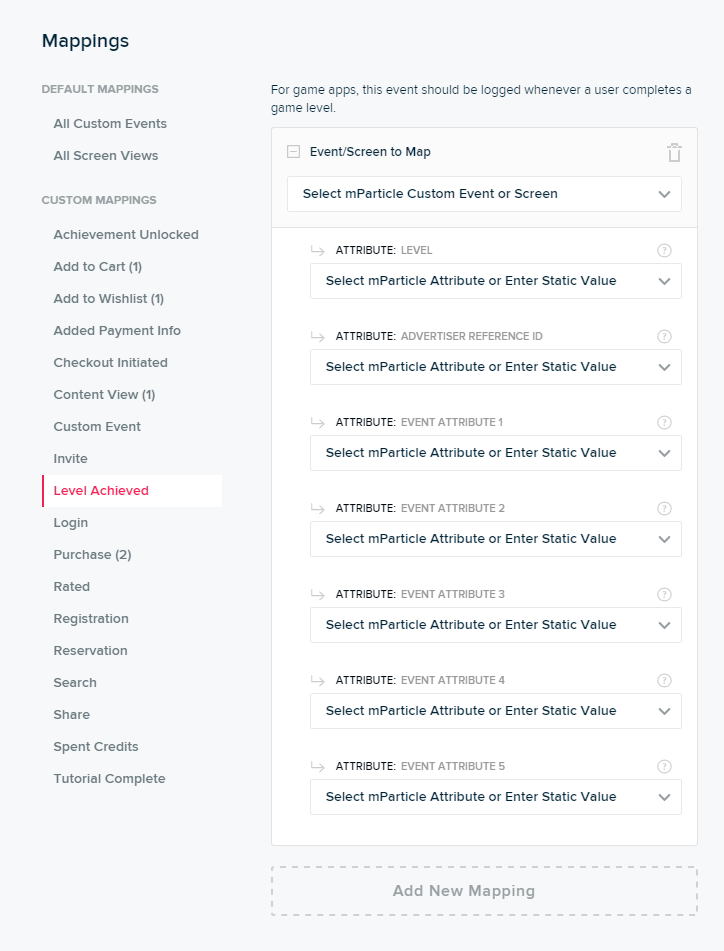
The following integrations support custom mappings:
- AgilOne
- Algolia
- Amazon Mobile Analytics
- AppLovin
- AppsFlyer
- Criteo
- Fiksu
- Google Ads Enhanced Conversions
- Google Analytics for Firebase
- Google Analytics 4 (GA4)
- Iterable
- NCR Aloha
- Optimizely
- SimpleReach
- Snapchat
- TikTok
If an event has a custom mapping configured for a particular connection, it will be noted within the Event Filters view.
If you turn off forwarding of an event with a Custom Mapping, the mapping information will be deleted.
mParticle Forwarder Module
The final and most crucial transformation step is the mParticle Forwarder Module itself.
After all your other transformations have been completed, the forwarder module turns your data into messages to the output in its preferred format.
Each integration has its own forwarding module. Settings for the forwarder are derived from three places:
- Some data is handled based on hard-coded settings. For example, any device information (such as device model or operating system type) the output service accepts is usually forwarded without the user needing to set anything up.
- Some data is handled according to the connection settings. For example, in the Mixpanel settings, you can choose whether you want to forward session events, and decide what they should be called.
- Any custom mappings you have created.
Based on these settings, mParticle transforms your data into a format accepted by the output. This can involve extensively reformatting the data. For example, Mixpanel’s API accepts events, with attributes given as a flat set of key-value pairs. To fit this structure, a single mParticle eCommerce event with four products will be transformed into four Mixpanel Events - one for each product - with common attributes, such as user and device info, repeated for each event.
The documentation for each integration will tell you what you need to know about how data is transformed to be accepted by the Output service.
Best Practice for Transformations
mParticle provides many opportunities to transform and enrich your data. It is often possible to perform the same transformation in more than one place. For example, if you wanted to drop all Application State Transition events for a given output, you could use the event filter, or you could write a condition in an output rule. There are advantages to each choice. The event filter can be used by anyone with the appropriate access to your organization in the mParticle Dashboard, so it is easy to update and maintain. Writing a rule gives you much finer control over your data, but rules may be difficult for non-developers to understand or alter.
Make the necessary transformations to your data in as few steps as possible. The fewer times you alter your data, the easier your integration will be to troubleshoot and maintain.
Was this page helpful?
- Last Updated: July 3, 2025